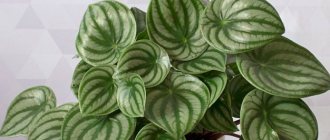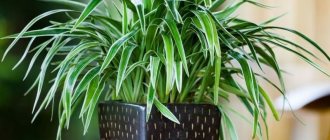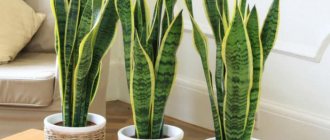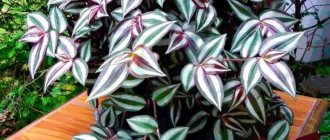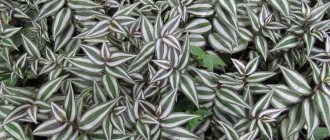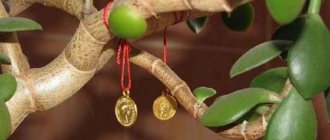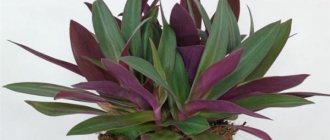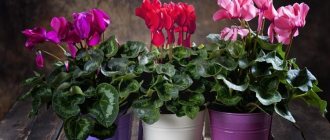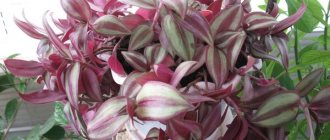Tradescantia is the name of a genus of evergreen plants whose natural habitat is located in America, in places with tropical and temperate climates. Species included in this genus are often grown at home, since it is easier to care for Tradescantia indoors, where it is easier to achieve the required high air humidity and a constant average temperature.
Growing the plant is not too difficult, but it is also profitable: all varieties have high decorative value, which allows you to decorate any room or greenhouse. This flower is beautiful not only during the flowering period, its unusual foliage attracts attention and distinguishes the plant from other species.
Magical and healing properties of Tradescantia. Growing Tradescantia at home
Tradescantia is part of the usual circle of cute, unpretentious plants (zebrina, chlorophytum, sansevieria, etc.), which have accompanied us since early childhood: in our parents' house, in kindergarten, in the school classroom, in a variety of institutions.
And no wonder: these plants are invariably healthy and attractive even with minimal care. And now you can still find plants from this modest circle, but, unfortunately, much less often. These “modest” plants have been replaced by more spectacular and beautifully flowering (but at the same time more demanding to care for) plants.
Tradescantia received the popular name “woman's gossip” for its stems, which hang down and intertwine so that they are difficult to separate from each other.
The magic and benefits of Tradescantia
Tradescantia protects its owners well from gossip and from malignant diseases. If a person begins to have similar problems, it takes away the negative energy, dries up and dies.
Tradescantia is a universal remedy for the evil eye. Get a Tradescantia, under its influence evil people will forget the way to your home.
Tradescantia is a source of joy and inspiration. It can charge you with energy, sharpen your sense of humor, and give hope. Among other things, it protects its owners from upper respiratory tract diseases.
Neutralizes envy, brings a feeling of joy, helps to survive unpleasant moments.
All Tradescantia belong to the airy Gemini, ruled by Mercury, the planet closest to the Sun. Mercury is an air planet. The air becomes warm and light with the participation of the fiery element of the Sun, which is why Mercury follows the Sun on its heels. The sun is a planet of great joy, strong, real feelings.
Tradescantia is useful to have in homes whose inhabitants have problems with the lungs, bronchi or arms. Tradescantia has a warming effect on these organs.
Tradescantia easily reproduces, grows very quickly and contains a complex of nutrients and medicinal substances, so they are often grown to feed indoor birds, turtles, hamsters, cats and other pets. Aquarists place a pot of young Tradescantia on glass lying on the sides of the aquarium, and the growing stems of the plant soon sink into the water and form a beautiful green mat on its surface. In addition, many fish are not averse to eating these delicate leaves.
Tradescantia purifies and humidifies the air in the room, neutralizes electromagnetic radiation. A person admiring its lush greenery relieves eye strain, quickly improves his mood and makes breathing easier.
Cats intuitively sense the usefulness of Tradescantia and happily chew its shoots and juicy leaves. So if there is a cat in your apartment, the plant will have to be protected from it by giving it a small amount of leaves as “living vitamins.”
The healing properties of Tradescantia
The healing properties of Tradescantia were discovered many centuries ago: it was grown for medicinal purposes in Buddhist monasteries in Asia and Latin America.
Most often, its leaves were used externally to heal wounds, like plantain in our country. But it is known that in some countries preparations from Tradescantia were taken orally: in Cuba - for infections of the gastrointestinal tract, colitis, gastritis, flatulence, in Venezuela - for diabetes, in Jamaica - for tuberculosis.
Tradescantia has long taken its rightful place in folk medicine, because its preparations have many medicinal properties: antimicrobial, anti-inflammatory, hemostatic, wound healing, carminative, antidiabetic. Tradescantia can also be used in the treatment of serious infectious diseases such as pulmonary tuberculosis. Shoots with leaves are used - both fresh and dried.
Tradescantia. Home care
Until recently, Tradescantia grew in almost every home, which is not surprising - Tradescantia is one of the easiest indoor plants to maintain, so even the laziest gardener can make friends with this plant.
Tradescantia is an unpretentious plant. It can be in the shadows or in the light. The temperature where it grows can also be different - from warm to cool. The only thing that the flower does not like is to be watered often.
Temperature. Moderate, optimal 24-26 °C. The winter minimum is 10-12 °C, although in the historical homeland temperatures drop even lower, to almost 2-4 °C.
Lighting. Tradescantia is considered undemanding to light, but this only applies to plants with dark green leaves. All variegated varieties and varieties are light-loving; it is advisable for them to receive a certain amount of direct sunlight (eastern or western window).
Watering. Quite abundant from spring to autumn - the soil should be slightly moist all the time, without excessive dampness; in winter, when the temperature drops, watering is more moderate. The soil needs to be loosened periodically to avoid rotting.
Fertilizer . From March to August, feed with fertilizer for indoor decorative foliage plants every two to three weeks.
Air humidity . Tradescantias love very humid air, optimally about 60%. Unfortunately, they often try to compensate for the lack of high humidity with abundant frequent watering, which is completely wrong. In nature, Tradescantia is a ground cover plant with an exclusively superficial root system. In apartments, Tradescantia especially suffers during the winter heating season.
Transplant . The soil for Tradescantia should be very loose, at the same time nutritious, rich in organic matter. pH - 5.5-6.5 or slightly acidic. Forest peat soil (3 parts) mixed with sand (1 part) is perfect. You can buy universal soil in the store, add 1 part vermiculite and 1 part sand to 3 parts of it. There must be good drainage at the bottom of the pot. The pots themselves are preferably wide but shallow; several plants are planted in one pot.
Reproduction . Taken from stem cuttings in spring, summer or fall, they root well within a week or two.
Growing problems . With age, most Tradescantia tend to become bare and lose their initially healthy appearance and dense foliage, this is genetically determined - in nature, Tradescantia is a creeping plant, it does not need to have a lush bush, it creeps and re-roots in a new place. Due to their rapid growth, annual rejuvenation by cuttings is recommended. In the spring, all branches are cut, rooted in water and replanted in fresh soil; you can plant all the cuttings in one pot, as they grew, or you can divide them. In any case, the plants quickly gain strength and become thicker and more beautiful than before. You should also remember to feed Tradescantia a month after transplantation.
What kind of plant is this and how to care for it?
As various signs say, Tradescantia has interesting properties.
Now there are about a hundred varieties of this indoor plant; it is a product of selection and created by a famous American botanist. The plant was named after John Tradescant. It must be said that he tried a lot and ended up with an unpretentious indoor plant.
Therefore, if you want to add some greenery to your home, you can pay attention to this flower. Of course, you will need to choose the optimal variety from a number of existing ones. In general, for the most part, only the most popular varieties are grown, which are easy to care for:
- White-flowered - has white flowers, the leaves are elongated.
- Variegated - small leaves with slight pink or white tints.
- River - on each side the leaves have a different color, on one side they are green, on the other they are burgundy.
- Lodgesa - foliage can be up to twenty centimeters long, the color is more than interesting, it has silver stripes.
- Scaphoid - leaves with soft edges.
If we talk about this plant in general and its general characteristics, then Tradescantia is characterized by the presence of rather large foliage, which has a green tint, but can slightly turn into a silver or purple tint . The stems can gradually spread out of the pot; each stem bears many flowers on a small stalk.
The unpretentiousness of this plant lies in its resistance to changes in conditions . Even if the conditions are not the most favorable, the plant continues to exist, but may slightly lose its decorative properties. However, the most optimal conditions should be noted:
- In winter - the temperature can be about 12 degrees, watering is required approximately every four days.
- In summer - the temperature should be maintained at about 24 degrees, watering is required more regularly, the soil surface should always be kept moist, but excessive overwatering should be avoided.
The plant prefers plenty of light, but there is no need to expose this flower to open rays. Therefore, sometimes it is preferable to slightly shade the Tradescantia. If you want to get a more interesting flower (in terms of decorative properties), then it is useful to periodically use fertilizers, just take some kind of complex fertilizer, which is sold in flower shops.
Main varieties
There are many varieties of this plant that are suitable for growing indoors and differ not only in external features, but also in requirements for care, soil composition and other conditions.
White-flowered
It is the most common type for indoor floriculture. It has bright green leaves, on which 2 silver stripes are clearly visible. The underside of the leaf blade is painted purple. The inflorescences are small and white.
Blossfeld
The plant is unpretentious, has creeping and thick stems, prone to strong branching. The leaves are narrow and dark green. A beautiful velvet edge is noticeable on the upper part of the leaf plate. Flowering can occur at any time of the year, which is why this Tradescantia arouses additional interest among florists. The color of the inflorescences can be:
- pink;
- violet;
- white;
- blue.
Prirechnaya
Characterized by long stems that hang down beautifully. When grown in pots, Tradescantia becomes like an emerald wig. The oval-shaped leaf reaches a length of 5 cm. The underside of the leaf blade has a beautiful purple color. White small flowers appear on the plant at any time of the year. This species is grown not only as an indoor plant, but also as a ground cover flower in flower beds.
Scaphoid
This variety is a succulent plant with thick and not too long stems that are prone to branching. Leaves up to 3 cm long and boat-shaped are densely arranged on them.
Striped
This Tradescantia differs from similar species in the unusual color of its leaves, the longitudinal stripes of which are of different colors. The color of the leaf blade depends on the chosen variety and can be purple, green or reddish. But the longitudinal stripes are silver, purple or white. In indoor conditions, the plant rarely blooms.
Sillamontana
An amazingly beautiful succulent plant with a creeping thick stem prone to strong branching. Lanceolate fleshy leaves grow alternately and have beautiful pubescence. There are varieties in which the lower part of the leaf blade is painted burgundy. Blue or purple inflorescences are not decorative.
Hairy
This tradescantia is not often found among gardeners. It is characterized by the presence of an erect stem and bright, pink-lilac inflorescences. The small leaves have dense hairs that form a velvety coating.
Virginskaya
This species reaches a height of almost 1 m and has linear, slightly bent leaf blades. Relatively large flowers are collected in inflorescences and have a pink, white, blue-violet or purple color. The flowering period occurs in May-July. This Tradescantia is valued for the decorative qualities of its inflorescences.
Anderson
Anderson's Tradescantia is suitable for growing not only indoors, but also in the flowerbeds of a summer cottage. Moreover, in cloudy weather it acquires additional decorative qualities and looks even more beautiful. The plant is cold-resistant and can easily withstand low temperatures. In our country, this variety has not yet become widespread, and obtaining seedlings can be problematic.
Purple
The stems of this tradescantia are creeping, leaf blades up to 15 cm long, colored purple or green, growing alternately. Some varieties have clearly visible pink stripes along the leaves. Light velvety pubescence is also noticeable. The flowers are small, pink.
Zebrina
A bush variety, the height of which reaches 1.8 m. The leaves are ring-shaped, the length of each does not exceed 10 cm. They have a rich range of colors, but all have characteristic stripes. The bottom of the leaf blade is purple. The flowers are small and have no decorative value.
Reo
A representative of this variety is only one plant. Its trunk is short and strong. It contains sword-shaped leaves up to 0.3 m long. Their lower part is red or purple in color, sometimes white or pink stripes can be observed. The flowers are of the axillary type and are not particularly decorative.
Small-leaved
This Tradescantia has long stems and is capable of forming a very lush crown when grown in pots. The leaves are oval-shaped and reach a length of 5 cm. Their lower part often has a contrasting purple color. Rarely blooms indoors.
Lodges
Tradescantia Lodgesa has good decorative qualities due to its long leaves. Inconspicuous white or pink flowers periodically appear on their upper part.
Beliefs about the flower
Now let's look at what signs exist about this flower:
- The presence of this plant in the house allows you to reduce the amount of negative impact of gossip and is generally considered an excellent protector against any evil intentions. In addition, Tradescantia has the property of a kind of protective screen , which limits you from the influence of any visitors who have envious and evil thoughts.
On the other hand, some consider this plant not the best option for the home, since Tradescantia can create a mood for excessive anxiety , so you should listen to your own feelings when you start such a plant.
This plant is considered capable of clearing space from various negative entities that can inhabit the space , but in order for the plant to “work” you need to take care of this flower. If the plant feels your care, it will repay you handsomely and serve you well.
If the Tradescantia suddenly dries out, although you carry out normal watering and provide optimal conditions, then this fact may indicate that the plant has taken on damage or the evil eye , the flower has warded off the damage from you, you should thank the Tradescantia and bury it somewhere.
In addition, you can evaluate the different zones of your apartment depending on the well-being of the plant , they perfectly sense negative zones and begin to fade there, accordingly, a work area, bed or something similar should not be located in these parts of the space.
- According to some beliefs, this plant can generally have a very significant impact on the owner’s everyday life; sometimes such a plant can help you get positive changes in your own existence and achieve some results.
Signs depending on the type
Botanists know more than a hundred species of Tradescantia. Science divides them according to the shape and length of leaves, color, flowers, and size. The most popular options for home:
- Zebrina is a protector from the evil eye and envy. A strong home flower that can become a talisman for all family members. Suitable for those who often encounter misunderstandings. Tradescantia will not allow rumors to spoil the owner’s reputation and will discourage ill-wishers from the house.
- Virgin - saves from depression, stress, nervous and restless conditions. According to signs, it is suitable for those who are often sad and despondent and live alone. Calms, gives peace of mind, helps to find balance.
- Anderson - gives joy, improves mood, attracts positivity, good friends and good acquaintances. Eliminates conflicts, helps to improve relationships between residents of the house, especially between parents and children.
- Blossfeld - allows the white streak to enter life. Suitable for those who are confused and in search of a path in life. Promotes emotional uplift and increased self-esteem. Attracts success and long-term luck, helps in career growth and goal achievement.
Can I keep it at home?
There are studies by scientists that confirm that Tradescantia has useful pharmacological properties, in particular bactericidal. Therefore, such a flower can reduce the number of various viral diseases. In addition, the plant purifies the air from various harmful impurities and reduces the impact of electromagnetic radiation.
This is a very relevant property for modern apartments, where a huge number of electrical appliances work and there is electrical wiring in almost every wall.
If you feel the influence of the evil eye or feel significant envy towards you, then it is quite important to get a Tradescantia in order to reduce such influences. Tradescantia helps create a carefree mood, adds a sense of humor and an easy attitude to reality.
If you have become overly gloomy or just want to add a little joy to your own home, you can also try this plant . Moreover, sometimes even the pleasant and interesting appearance of this flower can make your mood a little better. You will receive positive emotions.
On the other hand, climbing plants are considered a cause of concern . Tradescantia is one of those, that is, loaches.
Much depends on your individual properties and characteristics. After all, each person is unique and has their own preferences, which also affect their relationship with flowers. If you regularly take care of your Tradescantia, then, as said earlier, the flower will be grateful to you and will be able to show positive properties.
We recommend watching a video about Tradescantia:
The soil
The soil requirements for Tradescantia are as follows:
- drainage;
- nutritional value;
- neutrality.
You can buy soil at any gardening store. In addition, you can make the soil mixture yourself by mixing forest soil, sand and humus in a ratio of 2 to 1 to 1. To ensure drainage, each part of the soil mixture must first be calcined for 30 minutes, and only then mixed.
Characteristics of the variety and types of Tradescantia with names
Tradescantia is a perennial plant characterized by flexible, long, rapidly growing stems. The fleshy sprouts bear oblong oval leaves, attached with short petioles. The flower can have a solid or variegated green color.
The surface of the leaf blades can be either smooth or fluffy. During the flowering period, which begins at different times of the year, small inflorescences appear on Tradescantia, consisting of a large number of buds. In this case, only a couple of buds can open at a time. The flowers have long stamens, delicate petals and a dark green calyx.
Among the known 75 species of Tradescantia grown at home, some varieties are especially popular and widely cultivated: although in the photo their differences may seem insignificant at first glance, when buying flowers and making floral arrangements with them, their characteristics clearly appear.
Tradescantia white-flowered is one of the most famous varieties, divided into 2 varieties, the names of which are: “Aurea” (with yellow leaves and a greenish stripe) and “Tricolor” (with a green leaf blade and lilac and white stripes). The leaves grow up to 6 cm in length and 2 cm in width. Inflorescences of small white flowers form on the shoots.
Riverside Tradescantia is a flower with many fragile purple stems raised above the ground. There are many leaves on the plant, but they are small - 2-3 cm in length. The inner side of the leaf matches the color of the stem.
Rules for caring for Tradescantia at home
Despite the fact that Tradescantia is not the most fastidious plant, novice gardeners may encounter the problem of deterioration in the appearance of the flower. The most common problems and ways to solve them:
Home care
To improve the appearance of the plant, it is necessary to tie it up and provide support if it is not growing in a hanging pot. A vertical support can be inserted into the soil in which the flower grows, and the stems can be tied with threads. For decoration and support, you can also use wall mounts: leaning on them, the Tradescantia will curl.
To help the flower acclimatize, it needs to be transplanted into new soil and fertilized. However, if Tradescantia was purchased in winter or autumn, the plant should not be replanted; it is advisable to wait until spring. If necessary, replanting can be done in winter, but then the plant must be provided with additional lighting.
Unlike some indoor flowers, which can be planted in open ground in the summer, it is not recommended to carry out such a procedure with Tradescantia. So slugs and ticks can easily grow on it, and the scorching daytime sun can burn the leaves. However, you can take the pot outside in the morning and evening, leaving it in partial shade and not forgetting to spray it.
Choosing soil and pot
The basic requirements for a substrate for tradescantia are lightness, breathability, neutrality and nutritional value. To create such soil, you can purchase plant soil in the store and mix it with natural minerals: vermiculite and agroperlite (3 parts soil, 1 part each mineral).
Such soil turns out to be loose, dries quickly and provides air flow to the root system, so that water does not stagnate in it.
The pot itself should be wide, but shallow, and must have holes for draining excess water. It is preferable to choose pots made from plastic or hardwood. You should not take a ceramic pot - the roots are easily overcooled in it.
Lighting and temperature conditions
The light in the room should be very bright, but at the same time diffused: the scorching direct rays of the sun burn the leaves of the plant. You can shade a plant standing on a brightly lit windowsill using translucent Roman blinds. You can understand that the lighting is too weak by looking at the pattern on the leaf blades: it becomes blurry, inexpressive and pale. Optimal lighting can be achieved by placing a pot of Tradescantia near a western or eastern window.
The plant can also develop in artificial light if it is not turned off for 10-12 hours.
In spring and summer, the indoor temperature should be maintained at 23-25˚C, and the flower should be taken out into the open air in warm weather. If this is not possible, the room should be ventilated 1-2 times a day, but avoid drafts. In winter, the temperature in the room must be maintained at 14-16˚C; at lower temperatures the plant dies. Ventilation during the cold season is necessary, but it should be minimal, and there should be no flows of cold air in the room. Sudden changes in temperature are also unacceptable.
Possible problems
In poor lighting or hypothermia, the plant stretches out and loses its leaves. Bare stems are a sign of aging. With a lack of water or nutrients, the leaves become smaller and dry. “Striped” varieties turn green due to the abundance or lack of light.
Why do Tradescantia leaves and stems dry out?
| Causes | What to do |
| The plant does not have enough water | Water regularly |
| Spider mite infestation | Wash with warm water |
| The air in the room is too dry | Remove the plant from heaters, radiators, spray with water |
| Watering with too cold water | Water with warm, settled water |
The leaves often dry out not completely, but only at the tips. Such a plant loses its decorative effect; it must be pruned and then properly cared for. Overmoistening at low temperatures causes rotting of the base of the stem.
Diseases of indoor Tradescantia
The plant, resistant to most diseases and pests, suffers from fungus. If there is insufficient light or too high soil moisture, the plant is susceptible to gray rot. Tradescantia fungal disease is easier to prevent than to treat. As a preventive measure and treatment, it is recommended to water the soil once every 3 months with a solution of the “Rescuer” preparation or other suitable fungicide.
Pests
Spider mites, whiteflies, mealybugs, scale insects, and aphids are dangerous for Tradescantia. Insects first attack plants with more tender leaves. If you do not control pests, then all indoor flowers will suffer. Washing in the shower is effective against small numbers of aphids and spider mites. Scale insects and mealybugs are removed from the leaves by hand. In case of severe infection, treat with insecticides Actellik, Fitoverm.
How to propagate and replant a flower at home
Tradescantia can be propagated in one of three main ways: cuttings, dividing the bush and sowing seeds. The first method is simple and can be used year-round. Algorithm of actions for cuttings:
- You need to separate cuttings (5-6 pieces) from an adult flower and remove the leaves on the lower internodes.
- Place the cuttings in water for 7-10 days, cover them with a bag or jar.
Cuttings
The method of dividing a bush, in turn, is the fastest and helps to obtain several adult plants at once. The method is only suitable for adults (2-3 years) and heavily grown flowers. The procedure can be carried out in the spring before transplanting the plant into a new pot.
It is necessary to loosen the soil, remove the entire bush from the pot and free the roots from the remaining lumps of earth. You can divide the bush with a knife or your hands, but this must be done quickly and carefully. The separated parts need to be planted in separate containers, watered with warm water and complex fertilizer applied to the soil.
Dividing the bush
Of the methods presented, seed propagation requires the most effort. In addition, this method sometimes leads to the loss of varietal characteristics. In order for the seeds to germinate, you need to prepare fertile soil mixed with sand. The seeds are planted in the ground, watered with warm water and covered with film. During their germination, you need to maintain a room temperature of 20˚C and bright, diffused light. The greenhouse must be regularly ventilated and the sprouts must be sprayed. Plants grown in this way can bloom in the 3rd year.
Young plants will need to be replanted every 2-3 years; older plants need to be replanted as needed. An emergency transplant is needed if the earthen ball has turned sour or the root system has grown too much.
When replanting, you need to take a pot that is slightly larger than the previous one, has holes for draining excess liquid and a drainage layer. If the old earthen ball is in normal condition, there is no need to clear the roots from it: just move the plant to a new pot and add fresh soil to it. After transplanting, the flower needs to be watered.
The benefits and harms of tradescantia for the home
You can grow Tradescantia at home not only for interior decoration, but also for medicinal and preventive purposes. A flower in the house serves as a kind of filter for purifying and humidifying the air, which is beneficial for the respiratory system. When used externally, the plant promotes the healing of wounds and burns, and when used internally, it helps with gastrointestinal diseases and sore throat.
There is a widespread belief that Tradescantia is an indicator of energy in a room. In places with negative energy, the flower does not take root even with good care. However, at the same time, the plant can be bred to improve relations between relatives in the house: it has a positive effect on mood and helps to avoid family quarrels.
Tradescantia is also considered to protect the home of its owners from evil intentions, envy and gossip.
If a flower suddenly dries up, despite careful care, this may be evidence that it has warded off damage or the evil eye from its owners.
Growing this flower is recommended for people who smile little, feel unhappy and depressed. It is believed that Tradescantia attracts positive emotions and helps to see happiness in simple everyday things. When caring for such a flower, carelessness develops, the sense of humor and the ability to easily endure failures improve.
The benefits of Tradescantia for the home also depend on where it is placed: it is advisable to grow it in the kitchen and office, but you should not grow it in the bedroom: the harm from it in this room is that it, like any climbing plant, can lead to loss of love between spouses.
Contraindications to the use of herbal decoction
Like most plants, there are contraindications to using the herb for medicinal purposes.
It is not recommended to take medications:
- Pregnant and lactating women.
- Children under 3 years old.
- For allergies.
- In case of individual intolerance.
- At the stage of exacerbation of diseases of the kidneys, liver, stomach and intestines.
- If you have diabetes, take only with permission and under the supervision of a doctor, constantly monitoring your blood sugar levels.
A strong recommendation is to begin treatment with herbal medicine only after consulting a doctor. It is not advisable to use drugs based on Tradescantia for more than one month; you must take a break.
